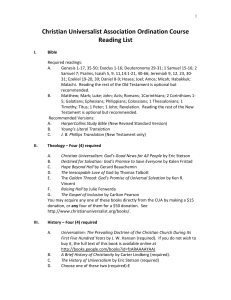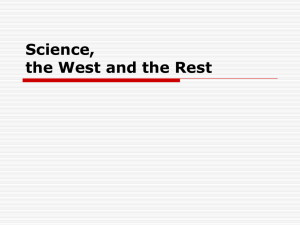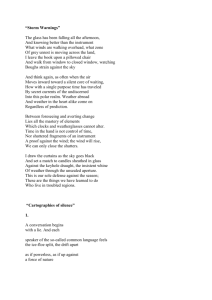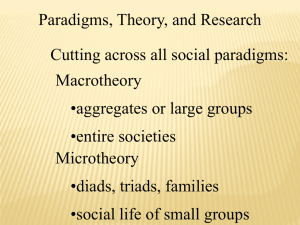Document 10464933
advertisement
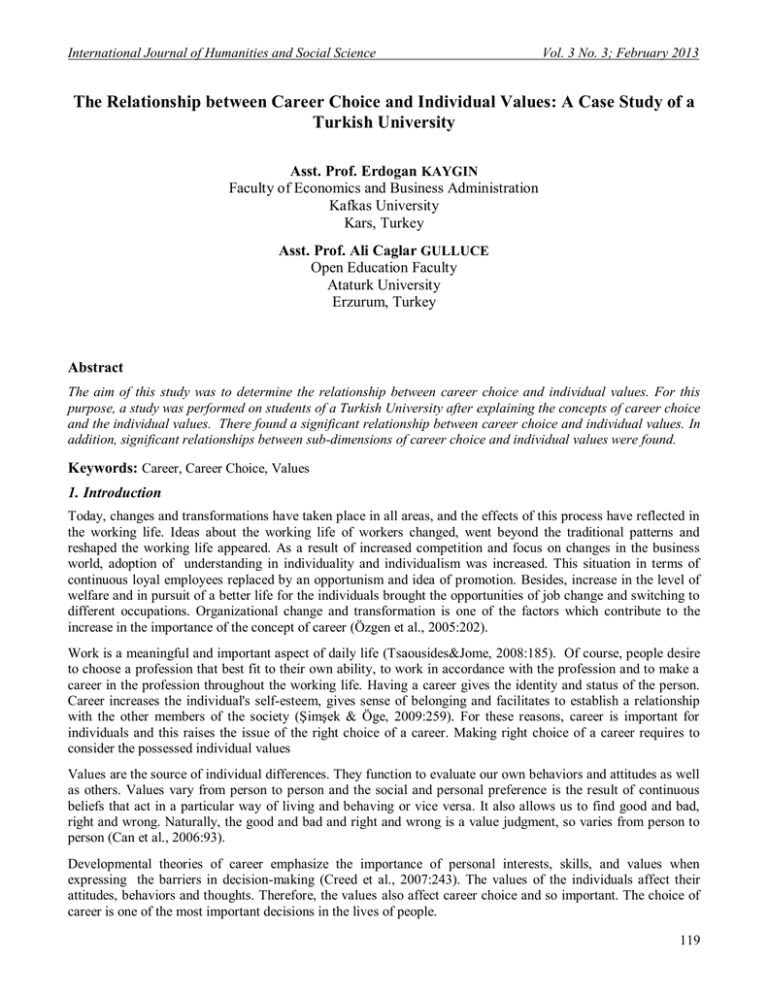
International Journal of Humanities and Social Science Vol. 3 No. 3; February 2013 The Relationship between Career Choice and Individual Values: A Case Study of a Turkish University Asst. Prof. Erdogan KAYGIN Faculty of Economics and Business Administration Kafkas University Kars, Turkey Asst. Prof. Ali Caglar GULLUCE Open Education Faculty Ataturk University Erzurum, Turkey Abstract The aim of this study was to determine the relationship between career choice and individual values. For this purpose, a study was performed on students of a Turkish University after explaining the concepts of career choice and the individual values. There found a significant relationship between career choice and individual values. In addition, significant relationships between sub-dimensions of career choice and individual values were found. Keywords: Career, Career Choice, Values 1. Introduction Today, changes and transformations have taken place in all areas, and the effects of this process have reflected in the working life. Ideas about the working life of workers changed, went beyond the traditional patterns and reshaped the working life appeared. As a result of increased competition and focus on changes in the business world, adoption of understanding in individuality and individualism was increased. This situation in terms of continuous loyal employees replaced by an opportunism and idea of promotion. Besides, increase in the level of welfare and in pursuit of a better life for the individuals brought the opportunities of job change and switching to different occupations. Organizational change and transformation is one of the factors which contribute to the increase in the importance of the concept of career (Özgen et al., 2005:202). Work is a meaningful and important aspect of daily life (Tsaousides&Jome, 2008:185). Of course, people desire to choose a profession that best fit to their own ability, to work in accordance with the profession and to make a career in the profession throughout the working life. Having a career gives the identity and status of the person. Career increases the individual's self-esteem, gives sense of belonging and facilitates to establish a relationship with the other members of the society (Şimşek & Öge, 2009:259). For these reasons, career is important for individuals and this raises the issue of the right choice of a career. Making right choice of a career requires to consider the possessed individual values Values are the source of individual differences. They function to evaluate our own behaviors and attitudes as well as others. Values vary from person to person and the social and personal preference is the result of continuous beliefs that act in a particular way of living and behaving or vice versa. It also allows us to find good and bad, right and wrong. Naturally, the good and bad and right and wrong is a value judgment, so varies from person to person (Can et al., 2006:93). Developmental theories of career emphasize the importance of personal interests, skills, and values when expressing the barriers in decision-making (Creed et al., 2007:243). The values of the individuals affect their attitudes, behaviors and thoughts. Therefore, the values also affect career choice and so important. The choice of career is one of the most important decisions in the lives of people. 119 © Centre for Promoting Ideas, USA www.ijhssnet.com In the choice of a career that is compatible with the values, job satisfaction, motivation, commitment and performance of an individual is high. Individual can have the opportunity to progress in the profession more easily. For doing the job the individual wants, creativity is higher and adaption becomes more easily to innovations. In general, giving a decision especially in adolescence that will affect the whole life can bring about anxiety and error. That situation comes to the fore even more for college students in the career planning stage that receive a high level of education, especially in their field (Pelit & Öztürk, 2010:208). In this context, the study aims to investigate the relationship between career choices that affect the lives of individuals and individual values which are the source of individual differences affecting the people's behavior. For this purpose, a research was conducted on the students of a Turkish University. 2. Career This concept began to be dealt in the 1970s and has become frequently heard in recent times (Bayraktaroğlu, 2006:137). The concept of career has been used in different meanings. While the dictionary meaning of the concept is stone quarry, running, place, path, walkway, arena, and figurative meaning is life, profession. Career in daily life refers to the person's experience of job and roles undertaken throughout life, occupation, business and success (Bayraktaroğlu, 2006:137). Career is defined as a developmental process that covers all the roles before, during and after the profession (Yazıcı, 2009:35), and consists of all the work done during an employee's working life (Özgen et al, 2005:195). Career is seen as a series of individual perceived attitudes and behaviors and integrated work-related activities during the life experience of a person. Each individual either a babysitter or a physicist or an academician or a manager automatically has a career. However, the individual must interpret his/her career in a meaningful way (Bingöl, 2006:285). Analysis of career-related definitions in common showed that the concept career is based on the degree of success in one's work, symbol of the advancement of work-related positions and the rise of taking up stages with the organization. The career of a person is composed not only with the duties but also have trainings in order to perform expectations, goals, feeling and desires on the role of business and promote with knowledge, skill, ability and desire to work (Bayraktaroğlu, 2006:137). Employees to achieve their career goals need to be knowledgeable about career choices and opportunities (Özgen et.al., 2005:195). Career selection process is the result of the interaction among the elements of attitudes, values and social support that the individuals have. Adoption of such a behavior pattern like choosing any career by an individual is certainly the product of a holistic assessment towards this behaviour (Genç et al., 2007:51). Career choice of individual depends on many situational and organizational factors (Price, 2009:268) and important for individuals. Making the choice of profession means a lot for the individual in terms of guiding and shaping the life. Because the choice of profession for an individual is the means of income-generating, job satisfaction, providing security, having respect and success. Understand the career choices and the career decisions of the individuals is an important component of recruitment and retention strategies (Price, 2009:269). The career decision covers the training decisions, as well as the professional decisions (Bright et al., 2005:563). Career decision-making difficulties arising from relevant emotional, and personality sources are among the most important challenges that college students may face (Saka & Gati, 2007:341). Final years of school are important in career decisions, because, these years are usually full with planning in attending the school or working, research and decision-making (Rogers et al., 2008:132). 3. The Concept of Value Different countries and societies that make up the world, depending on their cultures, have values that are similar or different. The values express the things within a culture that is preferred, attached importance and to be realized. Values have an important place in human life and actions (Turan et al., 2005:181). The values are the concepts that mankind thinks about for a long time (Dehghani, 2011:3079). The values can be defined as principles that guide the life of the individual as well as his work throughout the decision-making, problemsolving, communication, motivation, personal development, and on the other hand maintaining the integrity of subjects within the individual. Concept of value is a concept that is expressed explicitly or implicitly for good and desirable or bad and undesirable ideas (Huseyniklioğlu, 2010:12). Values are are defined as generalized beliefs about the desirability of behaviors and events (Hofer eta.al., 2007:17). 120 International Journal of Humanities and Social Science Vol. 3 No. 3; February 2013 Having done significant work in the concept of Value, Rokeach (1973) conceptualized value as the permanent belief by particular course of behaviour or purpose of the existence that is preferred against opponents socially or personally (Korkmaz Devranı, 2010:51). Meglino and Ravlin described the value as a belief internalized with an appropriate behavior (Hall & Davis, 2007:1589). Values are ideas that are not real. They are relative for this reason and can not be understood until being objective. Values are important because they constitute the social rules. They are fundamental while assessing the environment and conditions and also socially regulates human behavior (Dehghani, 2011:3079). The values affect all life, attitudes, the principles and precious things stemming from personality (Huseyniklioğlu, 2010:26). Values are the source for the criteria evaluating and judging people's thoughts and actions (Vurgun & Öztop, 2011:219) and also guiding to respond the universal needs of societies (Rice, 2006:234). Eduard Spranger believes that individuals have a set of values based on institutional, social, political, theoretical, religious, aesthetic, and economic values. Theoretical value based on discovery of truth and knowledge in being scientific and rational. This item is very functional and gives the best results when planning a situation or a problem. Social value is the working element of the public interest. Social value takes care of the human interaction and consider the impact of the activity on the group and the organization as a whole. Political value is associated with prestige and power, besides, it covers an important and power-oriented thinking. Religious values aim to make the world a better place and are based on the philosophical and interpretive argument. The aesthetic value sees the world from an artistic and interpretative vision. It respects harmony and order in a particular scenario. Economic value stems from functional and practical vision. Economic value stems from functional and practical vision and tries to find the available material goods (Hall & Davis, 2007:1590). Individual values are the representatives of the goals which are important for people or mental representatives of actuating forces. They are designated as emotional and intellectual principles that guide people's lives (Fegg et al., 2005:154). Individual values are the basis of an individual's point of view, for this reason, they are integral parts of an individual's behavior at the beginning of an decision-making process (Hall ve Davis, 2007:1589). The concept of individual values describes ideals, concepts and the elements that are important for an individual life (Huseyniklioğlu, 2010:26). They are also the factors that shape and improve the understanding of people‟s behavior. Values exist in a system where there are priorities (Kilbourne et.al., 2005:627). An individual, can exhibit a strong value such as religion or can attach importance to lots of values. For example, while economic, political, and institutional dimensions are usually higher in a masculine value profile; the religious, social and aesthetic values are lower (Hall and Davis, 2007:1590). Not only values differ between cultures but also between individuals who share the same culture. Freedom, security and success are the examples of typical values. Values are not limited to certain activities, issues or areas of study and cover all aspects of a person's life. Thanks to the defined criteria to compare the suitability between goals and values, the values help the individual which goals to choose (Hofer et al., 2007:17). The values are learned in the process of growth and maturation. They change throughout life, and individual‟s sense of self develops. Culture, societies and organizations surrounding us play a role in the formation of values (Can et al., 2006:93). Values that have been applied continuously as the internal reference affect our decisions and thus our lives. While questioning or making comparisons on morality and adequacy, we refer to a set of standards that we have and make judgments, based on our values and the importance that we believe, about the others what kind of values and the behaviors that they should have (Vurgun & Öztop, 2011:218) Some authors divide values into two main groups: instrumental and purposeful values. Instrumental values are the values that are intermediary in achieving objectives. These values are ambition, honesty, self-efficacy and bravery or courage. Purposeful values reflect the objective that will be achieved. Happiness, love, contentment, freedom, and self-esteem are kinds of this type. Both kinds of values act together to provide adopted ways to attain and to achieve these objectives (Can et al., 2006:93). As a result of comparisons between values, the "priority in value" is composed. Values that individuals have and being organized in order of importance among them also compose the system of values (Karalar & Kiracı, 2010:81). Therefore, when a value is important for any individual, it may not be important at the same level for another individual. 121 © Centre for Promoting Ideas, USA www.ijhssnet.com 4. Purpose of the Study This study aimed to investigate the relationship between career choice and individual values. This study depending on the main objective focused on the following topics: To determine the most preferred career dimensions of the participants, To determine the level of importance given to the values that the participants have, To determine the most important value(s) for each career dimension To determine whether there are differences between demographic characteristics and career choices of the participants, To determine whether there are differences between individual values and demographic characteristics of the participants. 5. Scope and Methodology of the Study Senior students of the University are the population of this study. There are about 300 students available in Business, Economics and Public Administration departments within Faculty of Economics. At the 95% confidence level with the 5% margin of error, the sample size was calculated as 169 (http: www.surveysystem.com/sscale.htm). However, 220 questionnaires, to reach a higher level representative of the population, were distributed taking into account inaccurate, incomplete response or unwillingness to participate in surveys. Of these 192 questionnaires were evaluated. Survey data collection form was used as a method of study. The survey consists of three parts. In the first chapter, scale of career dimensions, developed by Schein (1996) and adapted to Turkish by Aktas (2004), was conducted to determine the career preferences of the students. 16 items were used from the scale consisting of 27 items. There are 8 dimensions on the scale of career dimensions. These are dimensions of technical, independence, entrepreneurship, security, administrative, private life, competitiveness and respectability (Koca, 2009:99-100). In the second part, survey of individual values was used. Survey items related to individual values were quoted from the survey of values developed by Rokeach (1973). Part of purposive values consisting of 18 items was interpreted within the study. It was studied in 5 dimensions by the classification of Feather (1991). They are silence, universalism, achievement, positivism and individuality (Koca, 2009:101). The third section of the survey includes questions about demographic variables. 5 point likert scale was used for measuring expressions in Career choice and individual values. In our study, Cronbach's alpha coefficient was used as a measure of reliability. As a result of reliability analysis, it was found out that the scale of career choice consisting of 16 items was highly reliable (0,907) and also scale of individual values consisting of 18 items were found to be highly reliable (0,866). 5.1. Findings of the Study 5.1.1. Findings Related to Demographic Factors As shown in Table 1, while half of the respondents were male (50.0%), the other half was female 50.0%). Whilst the majority of respondents (79.2%) were at the age of 22-24, 13.5% were 25-27 years old. The ratio of 19-21 years (4,7%); 28 years and those over 28 years is very low. While almost of the students (92.2%) were single, 6.3% were married and rate of divorced/widowed were only 1,6%. While 41.2% of the students were in the department of economics, 32.8% was at the department of business administration; the ratio of students studying at the department of public administration was 26%. While analysis of monthly expenditure amounts who spends over $ 550 is 23.4%; of those who spend between 351-450 TL is 22.9%; of those who spend between 451-550 TL is 21,4%; of those who spend between 251-350 TL is 20,8%, and of those who spend $ 250 or less is 11.5%. While the participants in the study (40.1%) are mainly had primary and secondary education in the county, 26,6% of those in the province, 15,6% of those in the metropolitan; 12,5% in the village and 5,2% of those in the town. When the settlements in terms of the participants in the study living with their families examined; 31,3 % of those live in the county; 29,2% of those in the province; 19,8% of those in the village; 17, 2% of those in the metropolitan and 2,6% of those live in the town. 122 International Journal of Humanities and Social Science Vol. 3 No. 3; February 2013 Table 1: Distribution by Demographic Factors Number of People (N: 192) Percentage 96 96 50,0 50,0 9 152 26 5 4,7 79,2 13,5 2,6 12 177 3 6,3 92,2 1,6 63 79 50 32,8 41,2 26,0 22 40 44 41 45 11,5 20,8 22,9 21,4 23,4 24 10 77 51 30 12,5 5,2 40,1 26,6 15,6 38 5 60 56 33 19,8 2,6 31,3 29,2 17,2 Sex Male Female Ages 19-21 years 22-24 years 25-27 years 28 years and over Marital Status Married Single Divorced/Widow Department Business Administration Economics Public Management Monthly Expenditure 150-250 TL 251-350 TL 351-450 TL 451-550 TL 550 TL and over Settlement in Primary and Secondary Education Village County District Province Metropolitan Settlement that Participants Living with Families Village County District Province Metropolitan 5.1.2. Findings on the Sub-Dimensions of Mean and Standard Deviation Values in the Survey of Career Choice and Individual Values Findings on the sub-dimensions of mean and standard deviation values in the survey of career choice and individual values are summarized in Table 2&3. As shown in Table 2; „Private Life‟ is the most preferred career dimension by the participants (𝑥 =4,26). This is followed by „Administrative‟ (𝑥 =4,15) and „Security‟ (𝑥 =4,09) dimensions respectively. However, „Respectability‟ is the least preferred career dimension (𝑥 =3,71). Table 2: Sub-dimensions of Mean and Standard Deviation Values for Career Choice Scale Career Choice Technical Independence Entrepreneurship Security Administrative Private Life Competitiveness Respectability N 192 192 192 192 192 192 192 192 Mean 3,72 4,03 4,01 4,09 4,15 4,26 4,04 3,71 SD 1,008 0,906 0,926 0,998 0,905 0,780 0,865 1,071 123 © Centre for Promoting Ideas, USA www.ijhssnet.com "Achievement" value is determined to be the most important value for the research participants as in Table 3 (𝑥 =. This is followed by the values of „Individuality‟ and „Universalism‟ (𝑥 =4,09). „Positivism‟ is determined to be the least important value (𝑥 = Table 3: Sub-dimensions of Mean and Standard Deviation Values for Individual Values Individual Values Silence Individualism Achievement Universalism Positivism N 192 192 192 192 192 Mean 3,89 4,09 4,23 4,09 3,79 SD 0,654 0,719 0,730 0,822 0,803 5.1.3. Findings on the Relationship between the Scales of Career Choice and Individual Values Correlation analysis was used to determine the relationship between the career choice and individual values. The results are summarized in Table 4. Table 4: Relationship between the Scales of Career Choice and Individual Values Care Techni Independe Entrepreneu Secur Administra cal nce rship ity tive er Career Technical Priva Individ Competitive Respectab Silen Individual Achieve te ual ness ility ce ism ment Life Values Universal Positivi ism sm 1 ,733* * 1 Independenc ,760* ,429** e * 1 Entrepreneur ,749* ,453** ship * ,590** 1 ,733* ,382** * ,489** ,437** 1 Administrati ,785* ,532** ve * ,632** ,554** ,517* * 1 ,838* ,566** * ,584** ,613** ,609* * ,598** 1 Competitive ,809* ,523** ness * ,571** ,624** ,538* * ,544** ,686 ** 1 Respectabilit ,719* ,557** y * ,400** ,358** ,493* * ,449** ,538 ** ,510** 1 Individual Values ,676* ,472** * ,498** ,506** ,513* * ,559** ,655 ** ,476** ,473** 1 Silence ,578* ,390** * ,418** ,425** ,461* * ,491** ,499 ** ,433** ,425** ,859** 1 Individualis ,500* ,355** m * ,384** ,377** ,380* * ,425** ,478 ** ,312** ,357** ,802** ,628* * Achievemen ,620* ,440** t * ,467** ,448** ,468* * ,500** ,628 ** ,441** ,423** ,843** ,605* ,525** * 1 Universalis ,390* ,225** m * ,331** ,269** ,305* * ,339** ,393 ** ,235** ,296** ,732** ,584* ,906** * ,485** 1 ,416* ,273** * ,317** ,319** ,300* * ,347** ,428 ** ,254** ,317** ,708** ,490* ,465** * ,384** ,378** Security Private Life Positivism 1 1 ** p<0,01. There is a moderate (0,676) and positive significant (p<0,05) relationship between the scales of Career Choice and Individual Values. There is a high degree (>0,700) and positive significant (p<0,05) relationship between the Scale of Career Preference and its all sub-dimensions; also a moderate degree (>0,300) and positive significant (p<0,05) relationship between the Scale of Career Preference and all sub-dimensions of the Scale of Individual Values. 124 International Journal of Humanities and Social Science Vol. 3 No. 3; February 2013 Besides, there is a moderate degree (>0,300) and positive significant (p<0,05) relationship between all subdimensions of the Scales of Career Preference and Individual Values. 5.1.4. Results for Regression Analysis As shown in Table 5, independent variables explain 47.9% of the Career Choice Scale. Career Choice Scale is significantly affected by the sub-dimensions of “Achievement”, “Individuality”, “Silence” and “Universalism”. While the sub-dimensions of “Achievement”, “Individuality”, and “Silence” positively affect the Career Choice Scale, the sub-dimension of “Universalism” affects negatively. Table 5: Regression Analysis Results for the Scales of Career Choice and Individual Values Independent Variable Silence Individuality Achievement Universalism Positivism Corrected R2 F p B Value t p 0,262 0,443 0,380 -0,327 0,072 3,173 3,361 5,775 -3,031 1,312 0,002* 0,001* 0,000* 0,003* 0,191 0,479 36,135 0,000* As shown in Table 6, independent variables explain 26,3% of the sub-dimension “technical” of the Career Choice. The sub-dimension “technical” of the Career Choice is significantly affected by the sub-dimensions of “Achievement”, “Individuality”, and “Universalism”. Whilst the sub-dimensions of “Achievement”, “Individuality” positively affect the sub-dimension “technical” of the Career Choice, the sub-dimension “Universalism” affects negatively. Table 6: Regression Analysis Results for the Sub-Dimension “technical” of the Career Choice and SubDimensions of Individual Values Scale Independent Variable Silence Individuality Achievement Universalism Positivism Corrected R2 F p B Value t p 0,230 0,853 0,412 -0,692 0,019 1,648 3,839 3,706 -3,800 0,207 0,101 0,000* 0,000* 0,000* 0,836 0,263 14,653 0,000* As shown in Table 7, independent variables explain 24,4% of the sub-dimension “Independence” of the Career Choice. The sub-dimension “Independence” of the Career Choice is significantly affected by the sub-dimensions of “Achievement”. Table 7: Regression Analysis Results for the Sub-Dimension “Independence” of the Career Choice and Sub-Dimensions of Individual Values Scale Independent Variable Silence Individuality Achievement Universalism Positivism Corrected R2 F p B Value t p 0,178 0,243 0,375 -0,108 0,095 1,406 1,203 3,714 -0,651 1,121 0,161 0,230 0,000* 0,516 0,264 0,244 13,320 0,000* 125 © Centre for Promoting Ideas, USA www.ijhssnet.com As shown in Table 8, independent variables explain 26,4% of the sub-dimension “Entrepreneurship” of the Career Choice. The sub-dimension “Entrepreneurship” of the Career Choice is significantly affected by the subdimensions of “Achievement”, “Individuality”, and “Universalism”. Whilst the sub-dimensions of “Achievement” and “Individuality” positively affect the sub-dimension “Entrepreneurship” of the Career Choice, the subdimension “Universalism” affects negatively. Table 8: Regression Analysis Results for the Sub-Dimension “Entrepreneurship” of the Career Choice and Sub-Dimensions of Individual Values Scale Independent Variable Silence Individuality Achievement Universalism Positivism Corrected R2 F p B Value t p 0,249 0,610 0,343 -0,473 0,078 1,945 2,990 3,360 -2,828 0,912 0,053 0,003* 0,001* 0,005* 0,363 0,264 14,697 0,000* As shown in Table 9, independent variables explain 26,7% of the sub-dimension “Security” of the Career Choice. The sub-dimension “Security” of the Career Choice is significantly and positively affected by the sub-dimensions of “Achievement and Silence”. Table 9: Regression Analysis Results for the Sub-Dimension “Security” of the Career Choice and SubDimensions of Individual Values Scale Independent Variable Silence Individuality Achievement Universalism Positivism Corrected R2 F p B Value t p 0,360 0,411 0,379 -0,303 0,043 2,617 1,872 3,459 -1,685 0,468 0,010* 0,063 0,001* 0,094 0,640 0,267 14,904 0,000* As shown in Table 10, independent variables explain 33,3% of the sub-dimension “Administrative” of the Career Choice. The sub-dimension “Administrative” of the Career Choice is significantly and positively affected by the sub-dimensions of “Achievement, Individuality and Silence”. Table 10: Regression Analysis Results for the Sub-Dimension “Administrative” of the Career Choice and Sub-Dimensions of Individual Values Scale Independent Variable Silence Individuality Achievement Universalism Positivism Corrected R2 F p B Value t p 0,310 0,448 0,356 -0,307 0,075 2,564 2,328 3,702 -1,949 0,931 0,011* 0,021* 0,000* 0,053 0,353 0,333 18,585 0,000* As shown in Table 11, independent variables explain 44,4% of the sub-dimension “Private life” of the Career Choice. The sub-dimension “Private life” of the Career Choice is significantly and positively affected by the subdimensions of “Achievement, Individuality and Positivism”. 126 International Journal of Humanities and Social Science Vol. 3 No. 3; February 2013 Table 11: Regression Analysis Results for the Sub-Dimension “Private life” of the Career Choice and SubDimensions of Individual Values Scale Independent Variable Silence Individuality Achievement Universalism Positivism Corrected R2 F p B Değeri t p 0,088 0,344 0,500 -0,210 0,144 0,938 2,303 6,689 -1,713 2,300 0,349 0,022* 0,000* 0,088 0,023* 0,444 31,530 0,000* As shown in Table 12, independent variables explain 23,4% of the sub-dimension “Competitiveness” of the Career Choice. The sub-dimension “Competitiveness” of the Career Choice is significantly and positively affected by the sub-dimensions of “Achievement, Silence and Universalism”. Whilst the sub-dimensions of “Achievement” and “Silence” positively affect the sub-dimension “Entrepreneurship” of the Career Choice, the sub-dimension “Universalism” affects negatively. Table 12: Regression Analysis Results for the Sub-Dimension “Competitiveness” of the Career Choice and Sub-Dimensions of Individual Values Scale Independent Variable Silence Individuality Achievement Universalism Positivism Corrected R2 F p B Value t p 0,356 0,320 0,336 -0,318 0,003 2,917 1,647 3,451 -1,995 0,042 0,004* 0,101 0,001* 0,048* 0,966 0,234 12,669 0,000* As shown in Table 13 independent variables explain 22% of the sub-dimension “Respectability” of the Career Choice. The sub-dimension “Respectability” of the Career Choice is significantly and positively affected by the sub-dimensions of “Achievement” and “Silence”. Table 13: Regression Analysis Results for the Sub-Dimension “Respectability” of the Career Choice and Sub-Dimensions of Individual Values Scale Independent Variable Silence Individuality Achievement Universalism Positivism Corrected R2 F p B Value t p 0,328 0,313 0,342 -0,207 0,122 2,149 1,288 2,816 -1,039 1,197 0,033* 0,199 0,005* 0,300 0,233 0,220 11,782 0,000* 5.1.5. Results Concerning the Differences between Demographic Variables The results concerning the differences between demographic variables are presented in tables. 127 © Centre for Promoting Ideas, USA www.ijhssnet.com Table 14: Examination of Career Choice Scale and its Sub-Dimensions in terms of Gender Differences Scales Career Choice Technical Independence Entrepreneurship Security Administrative Private life Competitiveness Respectability Gender Male Female Male Female Male Female Male Female Male Female Male Female Male Female Male Female Male Female Number of People 96 96 96 96 96 96 96 96 96 96 96 96 96 96 96 96 96 96 Mean 3,88 4,13 3,58 3,86 4,02 4,05 3,87 4,16 3,91 4,28 4,03 4,28 4,10 4,43 3,96 4,12 3,60 3,83 Standard Deviation 0,857 0,504 1,130 0,854 1,006 0,798 1,077 0,724 1,071 0,888 1,000 0,788 0,917 0,574 0,995 0,71 1,171 0,954 t p -2,375 0,019* -1,946 0,053 -0,238 0,812 -2,203 0,029* -2,567 0,011* -1,885 0,061 -2,971 0,003** -1,252 0,212 -1,487 0,139 *: p<0,05, **: p<0,01 While there are significant differences (p<0,05) between male and female in sub-dimensions of Entrepreneurship, Security and Private life in terms of Career Choice Scale, there are no significant differences (p>0,05) in subdimensions of Technical, Independence, Administrative, Competitiveness and Respectability. The average of female was significantly higher than the average of the men with regard to the sub-dimensions of Entrepreneurship, Security and Private Life under Career Choice Scale. Table 15: Examination of Individual Values Scale and its Sub-Dimensions in terms of Gender Differences Sub-Dimensions Individual value Silence Individuality Achievement Universalism Positivism Gender Male Female Male Female Male Female Male Female Male Female Male Female Number of people 96 96 96 96 96 96 96 96 96 96 96 96 Mean 4,00 4,17 3,83 3,96 4,00 4,18 4,13 4,35 4,05 4,14 3,80 3,78 Standard Deviation 0,695 0,428 0,703 0,599 0,827 0,584 0,852 0,568 0,93 0,701 0,884 0,717 t p -2,001 0,047* -1,419 0,158 -1,713 0,088 -2,117 0,036* -0,701 0,484 0,179 0,858 *: p<0,05, **: p<0,01 While there is a significant difference (p<0,05) between male and female in sub-dimension of Achievement in terms of Individual Values Scale, there are no significant differences (p>0,05) in sub-dimensions of Silence, Individuality, Universalism and Positivism. The average of female was significantly higher than the average of the men with regard to the sub-dimension of Achievement under Individual Values Scale. 128 International Journal of Humanities and Social Science Vol. 3 No. 3; February 2013 Table 16: Examination of Career Choice Scale and its Sub-Dimensions in terms of Age Differences Sub-Dimensions Age Group 22-24 years 25-27 years 22-24 years 25-27 years 22-24 years 25-27 years 22-24 years 25-27 years 22-24 years 25-27 years 22-24 years 25-27 years 22-24 years 25-27 years 22-24 years 25-27 years 22-24 years 25-27 years Career Technical Independence Entrepreneurship Security Administrative Private life Competitiveness Respectability Number of people 161 31 161 31 161 31 161 31 161 31 161 31 161 31 161 31 161 31 Mean 4,06 3,72 3,77 3,47 4,05 3,92 4,08 3,69 4,16 3,74 4,22 3,82 4,35 3,85 4,11 3,71 3,75 3,52 Standard Deviation 0,598 1,099 0,939 1,303 0,851 1,163 0,840 1,256 0,951 1,168 0,806 1,275 0,637 1,226 0,745 1,296 1,000 1,387 t p 2,50 9 1,55 0 0,75 0 2,13 3 2,16 4 2,24 6 3,30 2 2,35 9 1,12 1 0,013* 0,123 0,454 0,034* 0,032* 0,026* 0,001** 0,019* 0,264 While there are significant differences (p<0,05) between the age group 22-24 years and 25-27 years in subdimensions of Entrepreneurship, Security, Administrative, Private life and Competitiveness in terms of Career Choice Scale, there are no significant differences (p>0,05) in sub-dimensions of Technical, Independence and Respectability. The average of age group 22-24 years was significantly higher than the average of 25-27 years with regard to the sub-dimensions of Entrepreneurship, Security, Administrative, Private life and Competitiveness under Career Choice Scale. Table 17: Examination of Individual Values Scale and its Sub-Dimensions in terms of Gender Differences Sub-Dimensions Individual value Silence Individuality Achievement Universalism Positivism Age Group 22-24 years 25-27 years 22-24 years 25-27 years 22-24 years 25-27 years 22-24 years 25-27 years 22-24 years 25-27 years 22-24 years 25-27 years Number of people 161 31 161 31 161 31 161 31 161 31 161 31 Mean 4,16 3,70 3,97 3,52 4,15 3,80 4,31 3,85 4,16 3,76 3,88 3,35 Standard Deviation 0,450 0,942 0,578 0,879 0,600 1,128 0,600 1,140 0,701 1,244 0,735 0,993 t p 4,232 0,000** 3,612 0,000** 2,539 0,012* 3,246 0,001** 2,515 0,013* 3,398 0,001** There are significant differences (p<0,05) between the age group 22-24 years and 25-27 years in all subdimensions and of Individual Values Scale. The average of age group 22-24 years was significantly higher than the average of 25-27 years with regard to the all sub-dimensions under Individual Values Scale. 129 © Centre for Promoting Ideas, USA www.ijhssnet.com Table 18: Examination of Career Choice Scale and its Sub-Dimensions in terms of Marital Status Sub-Dimensions Career Technical Independence Entrepreneurship Security Administrative Private life Competitiveness Respectability Marital Status Married Single/Widow/Divorced Married Single/Widow/Divorced Married Single/Widow/Divorced Married Single/Widow/Divorced Married Single/Widow/Divorced Married Single/Widow/Divorced Married Single/Widow/Divorced Married Single/Widow/Divorced Married Single/Widow/Divorced Number of people 12 180 12 180 12 180 12 180 12 180 12 180 12 180 12 180 12 180 Mean 3,55 4,04 3,38 3,75 3,83 4,04 3,33 4,06 3,88 4,11 3,79 4,18 3,58 4,31 3,25 4,09 3,33 3,74 Standard Deviation 1,121 0,669 1,245 0,991 1,052 0,897 1,354 0,877 1,464 0,963 1,076 0,892 1,379 0,707 1,323 0,805 1,420 1,044 t p -2,333 0,021* -1,239 0,217 -0,781 0,436 -2,677 0,008* -0,783 0,434 -1,434 0,153 -3,214 0,002* -3,358 0,001* -1,272 0,205 While there are significant differences (p<0,05) between the married and the unmarried in sub-dimensions of Entrepreneurship, Private life, and Competitiveness in terms of Career Choice Scale, there are no significant differences (p>0,05) in sub-dimensions of Technical, Independence, Security, Administrative, and Respectability. The average of sub-dimensions of Entrepreneurship, Private life, and Competitiveness for the unmarried was significantly higher than the average of the married under Career Choice Scale. Table 19: Examination of Individual Values Scale and its Sub-Dimensions in terms of Marital Status Sub-Dimensions Individual value Silence Individuality Achievement Universalism Positivism Marital Status Married Single/Widow/Divorced Married Single/Widow/Divorced Married Single/Widow/Divorced Married Single/Widow/Divorced Married Single/Widow/Divorced Married Single/Widow/Divorced Number of people 12 180 12 180 12 180 12 180 12 180 12 180 Mean 3,64 4,11 3,42 3,93 3,78 4,11 3,73 4,27 3,79 4,11 3,54 3,81 Standard Deviation 1,156 0,515 1,127 0,602 1,395 0,653 1,090 0,692 1,437 0,767 1,270 0,765 t p -2,763 0,006** -2,645 0,009** -1,568 0,119 -2,514 0,013* -1,316 0,190 -1,115 0,266 While there are significant differences (p<0,05) between the married and the unmarried in sub-dimensions of Silence and Achievement in terms of Individual Value Scale, there are no significant differences (p>0,05) in subdimensions of Individuality, Universalism, and Positivism. The average of sub-dimensions of Silence and Achievement for the unmarried was significantly higher than the average of the married under Individual Values Scale. 130 International Journal of Humanities and Social Science Vol. 3 No. 3; February 2013 Table 20: Examination of Career Choice Scale and its Sub-Dimensions in terms of the Students Attending Different Departments Sub-Dimensions Career Technical Independence Entrepreneurship Security Administrative Private Life Competitiveness Respectability Departments Business Admn. Economics Public Admn. Business Admn. Economics Public Admn. Business Admn. Economics Public Admn. Business Admn. Economics Public Admn. Business Admn. Economics Public Admn. Business Admn. Economics Public Admn. Business Admn. Economics Public Admn. Business Admn. Economics Public Admn. Business Admn. Economics Public Admn. Number of people 63 79 50 63 79 50 63 79 50 63 79 50 63 79 50 63 79 50 63 79 50 63 79 50 63 79 50 Mean 3,97 4,17 3,80 3,69 3,78 3,68 3,94 4,23 3,82 3,88 4,16 3,95 4,02 4,39 3,72 4,07 4,27 4,08 4,16 4,41 4,19 4,08 4,19 3,76 3,87 3,92 3,19 Standard Deviation 0,648 0,756 0,664 0,877 1,097 1,034 0,959 0,862 0,856 1,015 0,894 0,841 1,006 0,927 0,975 0,902 0,873 0,960 0,734 0,828 0,742 0,768 0,885 0,899 0,950 1,024 1,133 t p Difference 4,422 0,013* 2-3 0,196 0,822 3,733 0,026* 1,827 0,164 7,529 0,001** 1,031 0,359 2,108 0,124 3,984 0,020* 2-3 8,761 0,000** 3-1,2 2-3 2-3 While there are significant differences (p<0,05) between students attending different departments in subdimensions of Independence, Security, Competitiveness and Respectability; there are no significant differences (p>0,05) in sub-dimensions of Technical, Entrepreneurship, Administrative, and, Private life in terms of Career Choice Scale. The average of sub-dimensions of Independence, Security, and Competitiveness for the students attending the Department of Economics was significantly higher than the average of students attending Public Administration under Career Choice Scale. Besides, the average of sub-dimension of Respectability for the students attending the Department of Public Administration was significantly lower than the average of students attending the other departments. 131 © Centre for Promoting Ideas, USA www.ijhssnet.com Table 21: Examination of Individual Values Scale and its Sub-Dimensions in terms of the Students Attending Different Departments Sub-Dimensions Individual Value Silence Individuality Achievement Universalism Positivism Departments Business Admn. Economics Public Admn. Business Admn. Economics Public Admn. Business Admn. Economics Public Admn. Business Admn. Economics Public Admn. Business Admn. Economics Public Admn. Business Admn. Economics Public Admn. Number of people 63 79 50 63 79 50 63 79 50 63 79 50 63 79 50 63 79 50 Mean 4,05 4,18 3,97 3,89 4,04 3,68 4,16 4,15 3,91 4,13 4,34 4,19 4,17 4,18 3,85 3,76 3,91 3,64 Standard Deviation 0,578 0,635 0,474 0,627 0,678 0,601 0,647 0,784 0,683 0,811 0,740 0,588 0,779 0,848 0,803 0,712 0,835 0,845 t p 2,138 0,121 4,799 0,009* 2,109 0,124 1,589 0,207 3,032 0,049* 1,829 Difference 2-3 3-1,2 0,163 While there are significant differences (p<0,05) between students attending different departments in subdimensions of Silence and Universalism in terms of Individual Value Scale, there are no significant differences (p>0,05) in sub-dimensions of Individuality, Achievement, and Positivism. The average of sub-dimension of Silence for the students attending the Department of Economics was significantly higher than the average of students attending Public Administration under Individual Value Scale. Besides, the average of sub-dimension of Universalism for the students attending the Department of Public Administration was significantly lower than the average of students attending the other departments. 6. Results This study examined the relationship between career choice and individual values. According to the results; there is a moderate positive significant correlation between Career Choice and Individual Values. In addition, it is agreed that there is a moderate positive relationship between the all sub-dimensions of Career Choice Scale and Individual Values Scale. This result may be an important indicator of individuals having a successful and happy working life and the choice of a career that is compatible with the values. While "Private Life" (𝑥 =4,26) is the most preferred career dimension, “Respectability” (𝑥 =3,71) is the least preferred career dimension. This let us experience that individuals pay close attention to their professions not to limit their social lives and there is not an important distinction between well-known or not known institution due to the difficulty of finding a job. Participants in this study stated that while the most important value is "Achievement" (𝑥 =“Positivism” (𝑥 = is the least important value. Such an outcome is likely to be based on the individuals to ensure their business success, to desire to prove themselves and to contribute to society. The changing and complex working conditions make developing good relations difficult to continue and let the dimension “Positivism” to the least preferred value. The following conclusions were reached as a result of regression analysis: 132 The most important values for the students who prefer the “Technical” career dimension are the subdimensions of “Individuality”, “Achievement”, and “Universalism”. The most important value for the students who prefer the “Independence” career dimension is the subdimension of “Achievement”. International Journal of Humanities and Social Science Vol. 3 No. 3; February 2013 The most important values for students who prefer the “Technical” career dimension are the subdimensions of “Individuality”, “Achievement”, and “Universalism”. The most important values for the students who prefer the “Entrepreneurship” career dimension are the subdimensions of “Individuality”, “Achievement”, and “Universalism”. The most important values for the students who prefer the “Security” career dimension are the subdimensions of “Silence” and “Individuality”. The most important values for the students who prefer the “Administrative” career dimension are the subdimensions of “Individuality”, “Achievement”, and “Silence”. The most important values for the students who prefer the “Private Life” career dimension are the subdimensions of “Individuality”, “Achievement”, and “Positivism”. The most important values for the students who prefer the “Competitiveness” career dimension are the subdimensions of “Universalism”, “Achievement”, and “Silence”. The most important values for the students who prefer the “Respectability” career dimension are the subdimensions of “Achievement” and “Silence”. As a result of the regression analysis, "Achievement" was observed as the important value for the dimension of each career. The study also showed that the participants take care of the values such as “acceptance by the social environment, protection of their self-esteem and successing something to contribute to society” that express the dimension “Achievement”. The results of the analysis showed that there are no differences between demographic variables. The average of women were found to be significantly higher than the average of men in terms of gender variable taking into consideration the mean differences within the career choice, individual values and of sub-dimensions. The average of age group 22-24 years were found to be significantly higher than the average of age group 25-27 years in terms of age variable. The average of unmarried was found to be significantly higher than the average of the married in terms of the marital status. Furthermore, the averages of the students attending the Economics Department are significantly higher than the average of the students attending the Public Administration Department. This study may lead the prospective researchers to learn the most demanded career dimensions of the students and to show the ranking of the values that the students pay importance. Due to the implementation of the study at a faculty of an university does limit the relationship between the career dimension and the adopted value and may make it less generalized. This situation may urge researchers to do more research on the subject and may be with larger samples. Especially the studies conducted in different universities and different faculties may be more guiding for students. In addition, individuals who want to change career, job seekers, and even individuals who are not satisfied with their jobs should be included in the researches. 133 © Centre for Promoting Ideas, USA www.ijhssnet.com References Bayraktaroğlu, Serkan. (2006). İnsan kaynakları yönetimi. Adapazarı. Sakarya Yayıncılık. Bingöl, Dursun. (2006). İnsan kaynakları yönetimi. İstanbul: Arıkan Basın Yayım Dağıtım. Bright, Jim E.H, Pryor, Robert G.L., Harpham, Lucy. (2005). The role of chance events in career decision making. Journal of Vocational Behavior, 66, 561–576. Can, Halil, Aşan, Öznur, Aydın, Eren Miski. (2006). Örgütsel davranış. İstanbul Arıkan Basın Yayım Dağıtım. Creed, Peter A., Conlon, Elizabeth G., Zimmer-Gembeck, Melanie J. (2007), ,Career barriers and reading ability as correlates of career aspirations and expectations of Parents and their children. Journal of Vocational Behavior, 70, 242–258. Dehghani, Marzieh, Pakmehr, Hamideh, Mirdoraghi, Fatemeh. (2011). The role of students' socio-cultural and individual factors in their value attitudes. Procedia Social and Behavioral Sciences, 15, 3079–3083. Fegg, Martin J., Wasner, Maria, Neudert, Christian, Borasio, Gian Domenico. (2005). Personal values and individual quality of life in palliative care patients. Journal of Pain and Symptom Management, 30(2),154-159. Genç, Gülten, Kaya, Alim, Genç, Metin. (2007). İnönü üniversitesi tıp fakültesi öğrencilerinin meslek seçimini etkileyen faktörler. İnönü Üniversitesi Eğitim Fakültesi Dergisi, 8(14), 49–63. Hall, Dianne J.; Davis, Robert A. (2007), “Engaging Multiple Perspectives: A Value-Based Decision-Making Model”, Decision Support Systems, 43, ss. 1588–1604. Hofer, Manfred, Schmid, Sebastian, Fries, Stefan, Dietz, Franziska, Clausen, Marten, Reinders, Heinz. (2007). Individual values, motivational conflicts, and learning for school. Learning and Instruction, 17,17-28. Hüseyniklioğlu, Buket. (2010). Bireysel değerler ve örgütsel bağlılık düzeyi ilişkisi: asker hastanesi çalışanları üzerinde bir inceleme. Unpublished Ph.D Thesis. Adana: Çukurova University, Institute of Social Sciences. Karalar, Rıdvan, Kiracı, Hakan. (2010). Bireysel değerlerin sürdürülebilir tüketim davranışı üzerindeki etkisini belirlemeye yönelik öğretmenler üzerinde bir araştırma. İşletme Araştırmaları Dergisi, 2(2), 79-106. Kilbourne, William, Grünhagen, Marko, Foley, Janice. (2005). A cross-cultural examination of the relationship between materialism and individual values. Journal of Economic Psychology, 26, 624–641. Koca, Ayşe İpek. (2009). Üniversite öğrencilerinin değerleri ve bireysel özellikleri ile kariyer tercihleri arasındaki ilişki: çukurova üniversitesi‟nde bir araştırma, Unpublished Master Disseratation. Adana: Çukurova University, Institute of Social Sciences. Korkmaz Devrani, Tülay. (2010). Kişisel değerlerin kuramsal yapısı ve pazarlamadaki uygulamalar. Eskişehir Osmangazi University İİBF Journal, 5 (1), 49-70. Özgen, Hüseyin, Öztürk, Azim, Yalçın, Azmi. (2005). İnsan kaynakları yönetimi. Adana:Nobel Kitabevleri. Pelit, Elbeyi, Öztürk, Yüksel. (2010). Kariyer tercihinde kişisel değişkenlerin rolü: turizm ve öğretmenlik eğitimi alan öğrenciler üzerinde bir araştırma. Istanbul Ticaret University Journal of Social Sciences, 9(17), 207-234. Price, Sheri. (2009). Future directions for career choice research in nursing: a discussion paper. International Journal of Nursing Studies, 46, 268–276 Rice, Gillian. (2006). Individual values, organizational context, and self-perceptions of employee creativity: evidence from egyptian organizations. Journal of Business Research, 59, 233 – 241. Rogers, Mary E., Creed, Peter A., Glendon, A. Ian. (2008). The role of personality in adolescent career planning and exploration: a social cognitive perspective. Journal of Vocational Behavior, 73, 132–142. Saka, Noa, Gati, Itamar. (2009). Emotional and personality-related aspects of persistent career decision-making difficulties. Journal of Vocational Behavior, 71, 340–358. Şimşek, M. Şerif, Öge, H. Serdar. (2009). Stratejik ve uluslararası boyutları ile insan kaynakları yönetimi. Ankara:Gazi Kitabevi. Tsaousides, Theodore, Jome, LaRae. (2008). Perceived career compromise, affect and work-related satisfaction in college students. Journal of Vocational Behavior, 73, 185–194. Turan, Selahattin, Durceylan, Belgin, Şişman, Mehmet. (2005). Üniversite yöneticilerinin benimsedikleri idari ve kültürel değerler. Kırgızistan Türkiye Manas University Journal of Social Sciences, 13, 181-202. Vurgun, Levent, Öztop, Sezai. (2011). Yönetim ve örgüt kültüründe değerlerin önemi. Süleyman Demirel University İİBF Journal, 16 (3), 217-230. Yazıcı, Hikmet. (2009). Öğretmenlik mesleği, motivasyon kaynakları ve temel tutumlar: kuramsal bir bakış. Kastamonu Eğitim Journal, 17(1), 33-46. http:www.surveysystem.com/sscale.htm. 134


